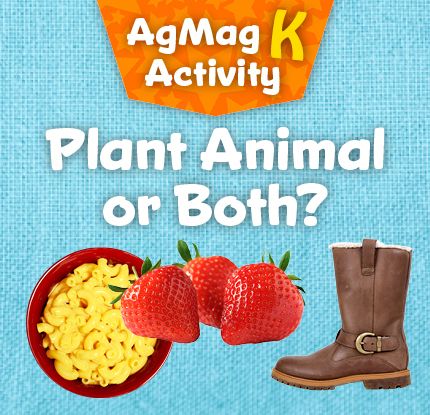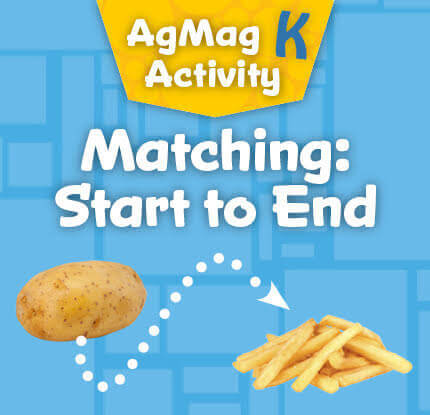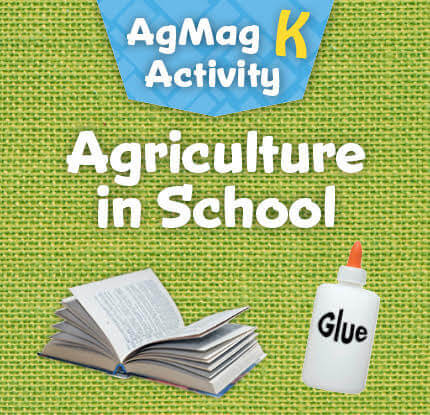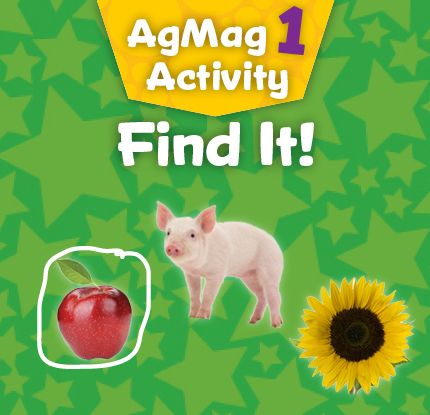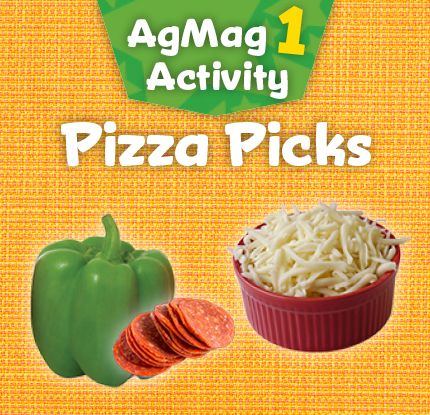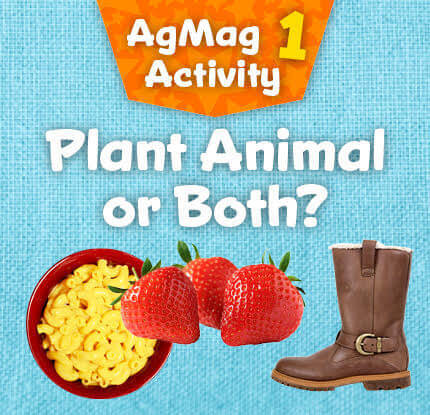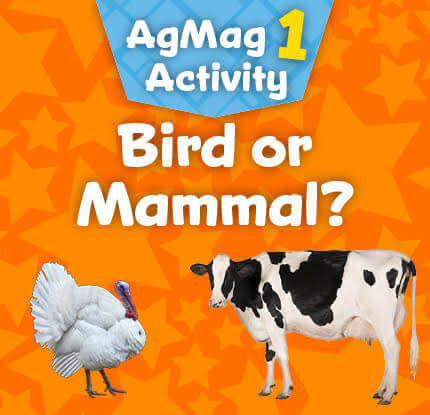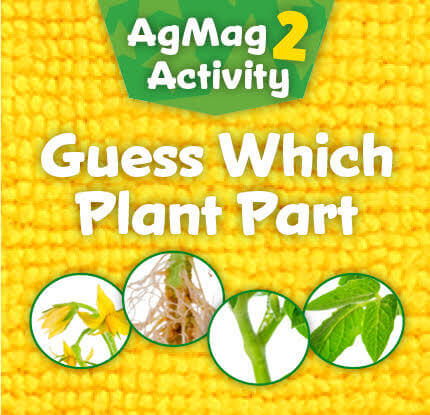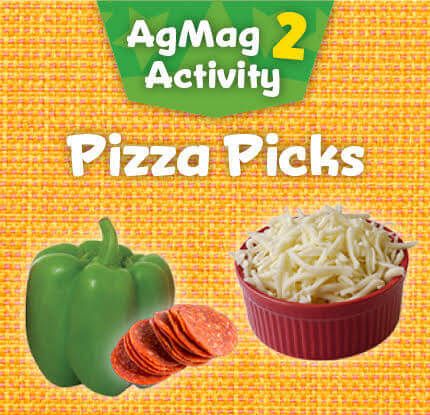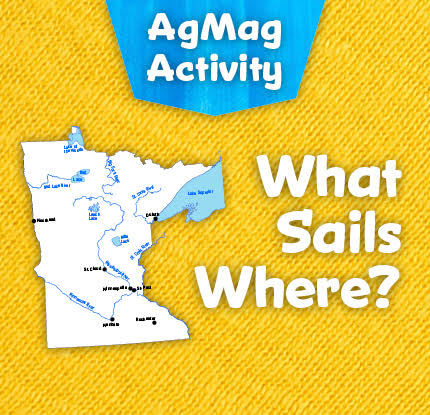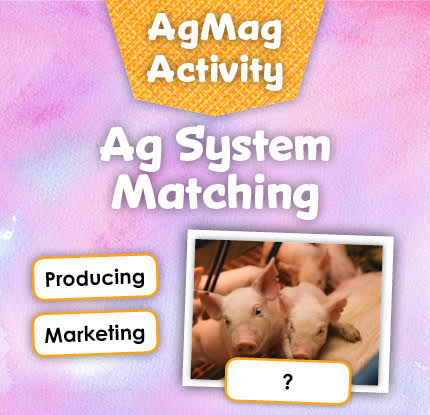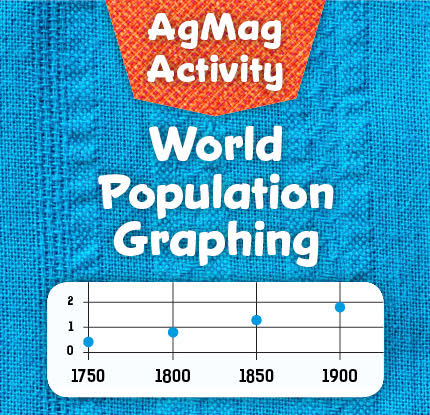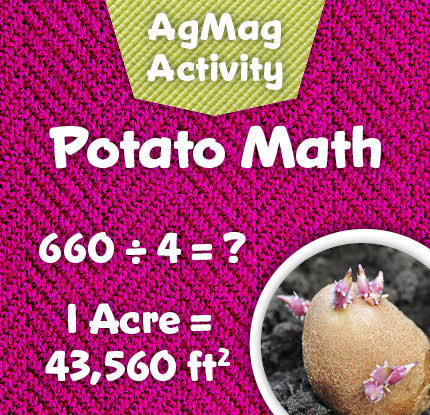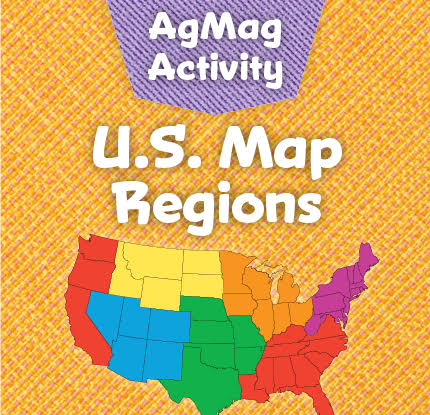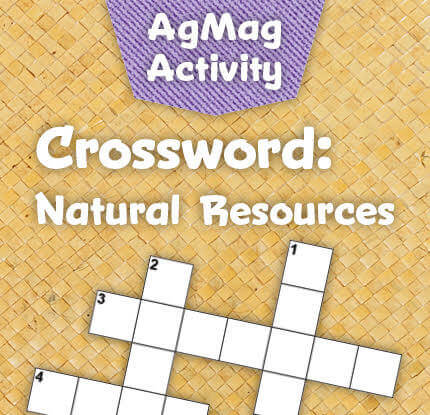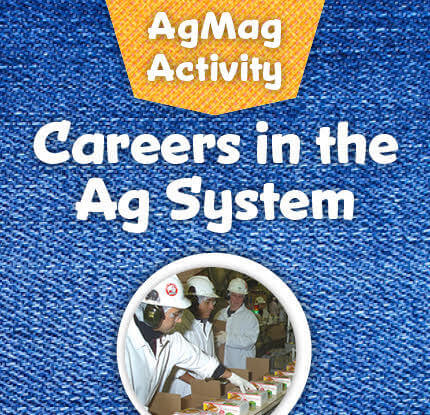
Welcome to the AgMag glossary!
Word Search
Click on a word to see its definition.
Click on a letter button to jump to another section of the glossary.
-
Agriculture
Growing plants and raising animals that people use for food, clothing, and many other things every day. It's also harvesting those farm products and getting them to us so we can use them.
Agriculture is the industry that grows, harvests, processes, and brings us food, fiber, fish, forests, sod, landscaping materials, and more. Agriculture is connected in some way with almost everything we eat, wear, and use.
Agriculture SystemThe steps required to get an agricultural product from the farm to the consumer. There are six steps that are usually involved: Producing, processing, distributing, marketing, consuming, and disposing. Not all systems have all six steps.
AnemiaWhen someone's blood does not have enough red blood cells. It can make people tired and pale.
AquacultureThe process of farming aquatic life, like fish and shrimp.
AquaticOf or relating to water, such as plants or animals that live in water.
AquifersUnderground areas of gravel, sand, or fractured rock, through which water can flow.
-
Bacteria
Microorganisms that grow and multiply quickly in warm temperatures. Bacteria is everywhere; some bacteria are helpful, other bacteria can be harmful.
Biological ControlControlling pests by bringing in a natural predator to that pest.
BiomeThe parts of the Earth's surface that are divided by climate, soil types, and the kinds of plants and animals that live within each part. Minnesota has four distinct biomes.
Bonanza FarmsLarge farms (usually from 1,500-100,000 acres) that focus on one or two highly valuable crops. These farms sell most of what they produce.
Buffer StripsA strip of land with grass or natural vegetation along waterways, lakes, and rivers that helps prevent pollutants from entering the waterways
BuffersA strip of land with grass or natural vegetation along waterways, lakes, and rivers.
-
Capital Resources
The things required to run a business. For food products, this would include things like tools, equipment, machinery, and factories.
CarbonA chemical compound that is necessary for plants to live and grow. However, too much carbon can affect the climate.
Cash CropsCrops grown by farmers not to be consumed by those farmers, but sold for money.
CelluloseThe main tissue in plants. Depending on the plant, it can be very tough. It can be used to make paper and some fabrics.
ClimateThe long-term patterns of weather in a particular area or region. Temperature, air pressure, humidity, precipitation, sunshine, cloudiness, and wind all impact the climate.
Commodity CropsCrops that someone grows or makes in order to sell it, not to use it themselves.
CompostingTaking things like grass clippings and food scraps and piling them together to begin the process of decomposition.
ConservationTaking action to preserve something, especially a natural resource
ConsumersPeople who buy and use goods. The process of buying and using those goods is "consuming."
Crop RotationGrowing first one crop in a field, and then another crop on the same land. Crop rotation makes nutrients available for crops and confuses bugs and weeds.
CropsPlants that are grown and harvested to feed people and animals or to make other things people need.
-
Disposing
Putting unused or waste products into recycling bins, compost bins, or garbage cans.
DistributionGetting the processed products to places where people can buy them, like grocery stores and farm markets.
Diversified FarmsFarms that grow a variety of crops and/or livestock, rather than just one or two types.
DecomposeA natural process that breaks down things like grass clippings and food scraps and eventually turns them into soil.
DistributingGetting processed products to places like grocery stores and farm markets.
DistributorsThe people and companies who get products from farms to consumers.
-
Equipment
Supplies and tools that are needed to do certain tasks.
EvaporationProcess in which a liquid transforms into a gas.
-
Farm
Areas of land where plants and animals are grown or raised for food, clothing, and more.
Farm (Agriculture) ProductsAnimals or plants raised on farms, or products made from them. Raw materials often must be changed (processed) to be of use. Example: Sheep are sheared to produce wool, but a hunk of raw wool has no practical purpose to someone who needs clothes. The wool is cleaned and processed into yarn, fabric, and eventually clothing, which are woolen products people can use.
FarmerA person who lives and works on a farm (also called producer). Farming is a career; farmers make money by selling their farm products.
FermentationThe process where a certain substance is broken down by bacteria, yeast, or other tiny organisms. One example is corn: Yeast is used to break down corn, and the corn becomes ethanol.
FertileSoil that is rich in nutrients and can produce a large amount of healthy crops.
FiberThe raw material from plants and animals, like cotton and wool, which are used to make cloth, rope, and more.
Fibrous MaterialsPlants that contain a great deal of fiber. Examples include hay and grass. This can make them hard for humans to digest.
FlumeA human-made water channel in which water is routed above the ground rather than through a ditch or trench.
-
Groundwater
Groundwater is the water found underground in aquifers.
Growing SeasonPeriod of the year that is warm enough for plants to grow.
-
Harvest
When crops are ripe or mature, they are removed from fields or gathered, and this is called harvesting.
HarvestingWhen crops are fully grown and ripe, they are removed from the field or garden for processing or consumption.
HomogenizationMixing the cream in milk with the thinner, watery parts so they stay blended together. If not homogenized, cream rises to the top.
HomogenizedThe process of breaking fat in milk into smaller droplets so they stay in the milk, rather than floating to the top to become cream.
Human ResourcesThe people needed to run a business. For food products, this includes farmers.
HybridWhat something is called when a new product is created by breeding two different plants to make a new and improved plant. For example, plant breeders develop hybrids that can resist drought and produce greater yields. Hybrids also give us a variety of new products. One example is the SweeTango apple, a hybrid of Zestar and Honeycrisp apples.
HydrologyThe study of water as a science.
HypoglycemiaSomething that can happen to people with diabetes when their blood sugar levels are too low. It can be dangerous.
-
Immigrants
A person who moves from one country to settle in another.
IndustryThe businesses, organizations, and people that provide a particular product or service.
InterdependentTwo or more people or things that depend on each other. This describes the relationship between farmers and people who need food and agricultural products.
IrrigationThe methods used by farmers to water farmland.
-
Landscaping Materials
Trees, shrubs, perennial plants, and annual plants used to decorate the outside of a home, business, or outdoor area.
LivestockFarm animals (including poultry) raised for food, clothing, and other products or uses.
-
Marketing
When products are advertised in places like TV and radio ads, magazines and newspapers, and the internet. Marketing helps agricultural producers get people to learn about their products.
MicrobesTiny organisms that can cause fermentation.
MulchingLaying things like grass clippings, leaves, or straw in the empty spaces around plants. This helps prevent weeds from growing.
-
Natural and Renewable Resources
Resources that can be replaced or grown again if they are used. This includes things like trees and water.
Natural ResourcesMaterials from the earth that humans use to consume or to make manmade products.
NitrogenAn important nutrient for plant growth. Plants use this to create amino acids, which are the foundation of protein.
-
Orchard
Land used to grow fruit or nut trees.
OrganicCrops that are grown without synthetic chemicals, and follow specific soil quality and (where applicable) animal-raising policies.
-
Pasteurization
Milk is heated to kill germs and make it safe for people to drink. Heating the milk also slows the growth of bacteria so the milk does not spoil as quickly.
PasteurizedA process of heating milk to a certain temperature for a period of time in order to kill harmful bacteria.
PhotosynthesisThe process used by plants to convert energy from the sun into chemical energy that supports the plants.
PollutantsSomething that introduces unclean elements into something else, especially water, soil, or air.
PrecipitationRain, snow, sleet, or hail that falls from the sky to the ground.
Precision FarmingUsing digital software, drones, and GPS systems linked to satellites to help farms be more productive and exact when planting crops, managing weeds and pests, and harvesting.
ProcessingChanging the raw materials into things we eat, wear, and use. For example, taking milk from a cow and changing it into yogurt.
ProducersPeople who grow or develop goods to provide or sell to others. The process of growing or developing is called "producing."
ProductionGrowing and harvesting plants or raising farm animals.
-
Raw Materials
A basic material that has not yet been processed into something else. For example, corn on the cob is a raw material. Later that corn can be changed, or processed, into something like ethanol.
Raw MilkMilk as it comes directly from the cow.
Rotational GrazingThe practice of moving cattle from one pasture to another to allow each pasture time to rest and regenerate.
RunoffWater that moves so fast the land cannot absorb it.
-
Shelf Life
The time a product can stay in the store before it starts to lose freshness. Milk shelf life dates are printed on the cartons and bottles. The milk will still be fresh for a few days after the date shown. Shoppers need to check shelf life dates on the milk they buy so they know it is still good to use.
Soil TypesAll soil is not alike. Soils are different based on the amount of sand, silt, and clay particles present. This is called soil texture. The soil texture affects the soil's ability to hold moisture, nutrients, and air. These factors influence the conditions needed for plant growth.
Specialized FarmsThose that grow mainly one crop.
StewardsPeople who manage or take care of things, including protecting the environment.
StewardshipTaking good care of something, like natural resources.
StoragePutting things in a place while they’re not being used.
Strip CroppingA method of farming that alternates types of crops through a field in narrow strips, often to prevent soil erosion.
Subsistence FarmersFarmers who grow just enough food to feed themselves and their animals, and sometimes a little extra to use for trading and bartering.
Surface WaterWater on the surface of the Earth, such as lakes, ponds, and streams.
Sustainable PracticesTechniques for farming that protect soil, water, and air quality.
-
Terrain
The physical features of an outdoor area. This includes elevation, slope, vegetation, and surface material. Terrain affects water movement and how water drains. It can also affect weather and climate patterns.
TillagePreparing land for farming by digging, stirring, or overturning soil in order to provide an environment that’s best for proper seed germination.
TranspirationThe process where moisture travels through a plant, with much of it eventually evaporating.
TransportationTaking people or things and moving them from one place to another.
TurfThe upper surface of soil that is made up of grass and plant roots.
-
Variable Rate Application
A process in which technology is used to help farmers determine where specifically they do or do not need fertilizer or soil nutrients.





























